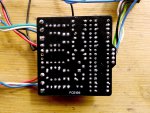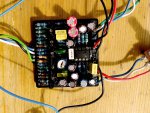Hello there,
Some months ago I bought one Procrastinator PCB from Germany. Assembled everything and nothing happened. As the unsoldering job is sometimes expensive as buying one new, I purchased again the PCB. Checked every component before soldering, ready and............ Nothing. The audio signal go well when the effect is off (which makes me think that the wiring is OK), but no sound when engaged - I recorded a bit in my DAW and when I normalized the audio take it could be heard distorted signal. That could be a good sign maybe-.
I don´t have no much experience with audio probes, maybe someone here could give me some advice. I checked for cold joints but apparently is none. I suspect there could be a false contact in the transistor´s sockets, but honestly I am clueless.
Thanks in advance and hope to read from you soon!
Ariosto
PS: Sorry for the poor quality photos. If needed, I could make some more in the next days.
Some months ago I bought one Procrastinator PCB from Germany. Assembled everything and nothing happened. As the unsoldering job is sometimes expensive as buying one new, I purchased again the PCB. Checked every component before soldering, ready and............ Nothing. The audio signal go well when the effect is off (which makes me think that the wiring is OK), but no sound when engaged - I recorded a bit in my DAW and when I normalized the audio take it could be heard distorted signal. That could be a good sign maybe-.
I don´t have no much experience with audio probes, maybe someone here could give me some advice. I checked for cold joints but apparently is none. I suspect there could be a false contact in the transistor´s sockets, but honestly I am clueless.
Thanks in advance and hope to read from you soon!
Ariosto
PS: Sorry for the poor quality photos. If needed, I could make some more in the next days.
Attachments
Last edited:






